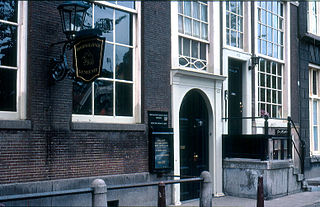
The Mennonite Church in the Netherlands, or Algemene Doopsgezinde Sociëteit, is a body of Mennonite Christians in the Netherlands. The Mennonites are named for Menno Simons (1496–1561), a Dutch Roman Catholic priest from the Province of Friesland who converted to Anabaptism around 1536. He was re-baptized as an adult in 1537 and became part of the Dutch Anabaptist movement.

The Frans Hals Museum is a museum located in Haarlem, the Netherlands.

The Zuiderhofje is a hofje in Haarlem, Netherlands.
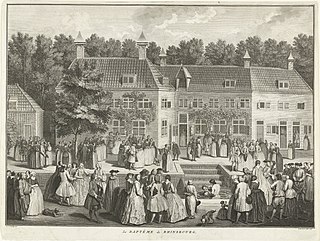
In Christian history, the Collegiants, also called Collegians, were an association, founded in 1619 among the Arminians and Anabaptists in Holland. They were so called because of their colleges (meetings) held the first Sunday of each month, at which everyone had the same liberty of expounding the scripture and praying.

Schutterij refers to a voluntary city guard or citizen militia in the medieval and early modern Netherlands, intended to protect the town or city from attack and act in case of revolt or fire. Their training grounds were often on open spaces within the city, near the city walls, but, when the weather did not allow, inside a church. They are mostly grouped according to their district and to the weapon that they used: bow, crossbow or gun. Together, its members are called a Schuttersgilde, which could be roughly translated as a "shooter's guild". It is now a title applied to ceremonial shooting clubs and to the country's Olympic rifle team.

Pieter Teyler van der Hulst was a wealthy Dutch Mennonite merchant and banker, who died childless, leaving a legacy of two million florins to the pursuit of religion, arts and science in his hometown, that led to the formation of Teyler's Museum. This was not the value of his entire estate. He also founded Teylers Hofje in his name, and made important donations to individuals in the Mennonite community.

The Vrouwe- en Antonie Gasthuis is a hofje on the Klein Heiligland 64a in Haarlem, Netherlands. It is open on weekdays from 10-17.00.

The Fundatiehuis is the former family home of Pieter Teyler van der Hulst on the Damstraat 21 in Haarlem, Netherlands. After his death it became the seat of the Teylers Stichting and through its front door, visitors could reach the Oval room.

The Grote Houtstraat is a shopping street in Haarlem that connects the Grote Markt to the Houtplein in the direction of the Haarlemmerhout woods.

The Doopsgezinde kerk is a historical hidden Mennonite church dating from the 17th century between the Grote Houtstraat, Peuzelaarsteeg and the Frankestraat in Haarlem, Netherlands.
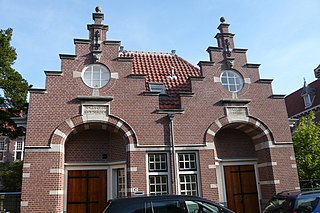
The Coen Cuserhof is a former orphanage in Haarlem. The complex was designed by J.A.G. van der Steur and the original maquette is on display in the Historisch Museum Haarlem.
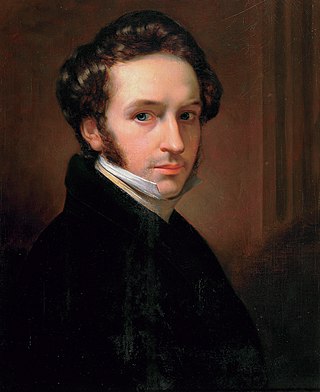
Jan Adam Kruseman was a Dutch painter, known primarily for his portraits, although he also did landscapes and genre scenes.

The Eerste Schilderijenzaal, or Painting Gallery I, is one of two art gallery rooms in Teylers Museum and is the oldest art gallery for contemporary Dutch art in the Netherlands. It was built onto the back of Teylers Oval Room in 1838. It was the young museum's first exhibition space for paintings and could be entered through the Oval Room, which was itself located behind the Fundatiehuis, the former home of Pieter Teyler van der Hulst.

Abraham de Vries was a Dutch Mennonite minister, author on literature and member of several societies.
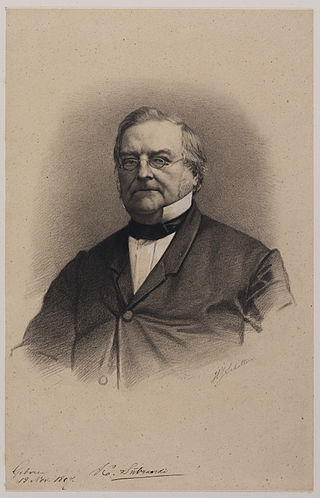
Klaas Sybrandi, also spelled as Sijbrandi, was a Dutch Mennonite minister, author, translator and involved with several societies and foundations.

Vincent Loosjes, was a 19th-century writer and publisher from the Northern Netherlands.

Klaas van der Horst was a Dutch Mennonite teacher and minister.

Barend Hartman van Groningen was a Dutch Mennonite teacher and minister.
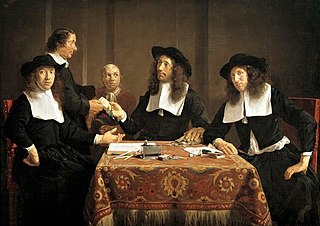
A regents group portrait, is a group portrait of the board of trustees, called regents or regentesses, of a charitable organization or guild. This type of group portrait was popular in Dutch Golden Age painting during the 17th century, and in the 18th century. They were intended to be hung in the regentenkamer, the regents' meeting room, or another prominent location in the institution.
The South African Children's Home was a building on the end of Long Street in Cape Town. It housed the only orphanage in South Africa from its foundation in 1815 until 1923. It was the home of South African College from 1829 to 1841. After the Children's Home left the building, it was changed and dismantled piece by piece until the last remnants - part of a modern red brick building - were demolished in November 1981.






















